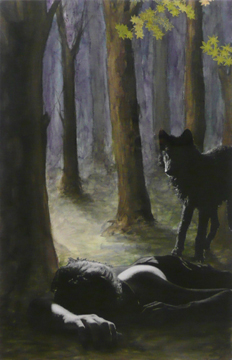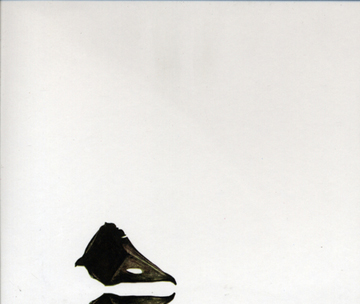As promised, here is a list of some recent artists and projects, about which I am particularly enthusiastic, that explore the occult from a queer perspective.

1. Originally from Toronto, and now based in Paris, Scott Treleaven is probably best known for his occult/queercore zine This is the Salivation Army (recently compiled and co-published by Printed Matter, Inc. and Art Metropole as The Salivation Army Black Book) and his darkly erotic collages, although he has also made a number of hypnotic, Kenneth Anger-like films. His collage works usually picture young men engaged in mysterious, ritual-like activities. The pictures combine heterogeneous sources and surfaces. We might find any combination of original and found photography (some of it likely film stills), historical prints illustrating alchemical and mystical ideas, cut chiyogami paper, and atmospheric fields of watercolor, etc. Generally, his compositions possess a hieratic quality, achieved through pronounced symmetry and conspicuous framing devices. We know immediately that we are in a mythic space when looking at one of his pictures.
So, what is the nature of the spell cast by Treleaven in his collages? I have a hunch it has to do with imagining some form of ecstatic fraternity as an alternative to the forms of community that are available in contemporary society, including the gay mainstream. I am thinking of the wolves that appear so frequently in his work. They are certainly cyphers for unfettered desire, but their significance also seems to lie in their highly social nature. His boys run in packs. I’ve also noticed that the young men in his pictures either appear alone or in groups of three or more. Rarely are they arranged as a duo, which would connote more conventional ideas of romantic desire. The collaborators he has brought into the fold for his films also leads me to believe that he is trying to reimagine a queer community based on creativity and sprituality: AA Bronson, Genesis Breyer P-Orridge, and the performance art duo, Massimo & Pierce (see below), amongst others, have been featured in his films. I highly recommend Treleaven’s essay, “My Little Underground,” in Generation Hex (ed. Jason Louv, Disinformation Co. Ltd., 2005), which chronicles his search for identity and community in the occult, queer, and punk subcultures.

2. My favorite record released this past year (which can neither be rightly called a new recording or a reissue—more below on that) is Coil’s The New Backwards. For those unfamiliar with their work, Coil were a post-industrial, experimental electronic band founded in 1983. Along with Psychic TV and Chris & Cosey, they rose out of the ashes of industrial music pioneers, Throbbing Gristle. Although many collaborators have come and gone Coil were, at their core, a duo comprised of John Balance and Peter “Sleazy” Christopherson. A great archive of Coil-related info is maintained by the good folks at Brainwashed here. Describing Coil’s music is difficult as they transformed their sound regularly but, generally speaking, they offered a poetic and emotional take on electronic noise, with Balance’s warm, sometimes foreboding, voice floating through the psychedelic bedlam. Listen here.
After the sad passing of John Balance (born Geff Rushton, and also known as Jhon Balance and Jhonn Balance) in 2004, Coil’s other half, Christopherson, returned to tracks originally recorded in Trent Reznor’s New Orleans studio in the early 90s for their follow-up to Love’s Secret Domain (which many fans consider their finest moment and my introduction to the band when I was a teenager). That record, originally to be titled Backwards, was infinitely delayed while Coil pursued other projects, thus acquiring quite a reputation amongst the band’s rabid fan base. Reworking those tracks in the aftermath of Balance’s death, Christopherson brought in a bevy of Coil’s past collaborators to help him with what must have been a very emotional project. The Ape of Naples followed in 2005 and The New Backwards earlier this year (an informative review of the latter record can be found here). The posthumous treating of earlier material offended some fans, but I don’t think it is out of keeping with Coil’s process of making music, which frequently involved esoteric ideas and practices, such as their collaboration with an extra-terrestrial being under the monikor, ELpH.
The New Backwards is less mournful than its predecessor, The Ape—more tense, violent, sexual. In my favorite track, “Copacaballa,” Balance sneers, “I want to be a stranger, become a shape changer,” over a rippling rhythm embellished with percolating noise, the whole sounding to me like a psychedelicized Front 242 or Nitzer Ebb. I love that lyric: it dramatizes for me a desire to get out of one’s skin, a desire for new experience, to become strange to one’s self through transformation. That seems to be a reoccuring theme on this record. On opener, “Be Careful What You Wish For,” an electronically distorted voice rasps “god please fuck my mind for good,” perhaps indicating the dangerous extreme of that desire.
I personally love Coil as much for their music as their attitude towards making it. In a recent interview, when asked whether he had a specific goal as an artist, Christopherson replied with the best possible answer, to my ears, anyway:
I believe that, for humanity to progress, the model of the world, of reality, that parents pass on to their children needs to be replaced when the kids are in their teens by a darker more complex vision. One, taking into account all kinds of miasma, multiple plans of existence, sexual liberation, human perversity, idiocy, and beauty. I feel that only benevolent outsiders, such as visionary homosexuals who bare their artistic souls in public, are fully qualified to do this. As long as children stay with the model of reality provided by their folks, no progress will be made.
My goal is to provide the same service for like-minded kids, that William Burroughs did for me, when I first read the Naked Lunch as a 13 year old in the back on a dingy WH Smith’s bookshop in Pontefract, Yorkshire…
How’s that for a statement of purpose!?!
Stay tuned tomorrow for “Gay Witches, pt. 3″…




Pingback: Gay Witches, Part 3 | Art21 Blog